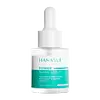What's inside
What's inside
 Key Ingredients
Key Ingredients

 Benefits
Benefits

 Concerns
Concerns

 Ingredients Side-by-side
Ingredients Side-by-side

Water
Skin ConditioningNiacinamide
SmoothingSaccharide Isomerate
HumectantGlycerin
HumectantHydroxyethyl Urea
HumectantPentylene Glycol
Skin ConditioningBetaine
HumectantBiosaccharide Gum-1
HumectantCentella Asiatica Leaf Extract
Skin ConditioningPropanediol
SolventPhenoxyethanol
PreservativePEG-40 Hydrogenated Castor Oil
EmulsifyingInositol
HumectantHydroxyethyl Acrylate/Sodium Acryloyldimethyl Taurate Copolymer
Emulsion StabilisingPolyacrylate Crosspolymer-6
Emulsion StabilisingPEG-7 Glyceryl Cocoate
EmulsifyingAllantoin
Skin ConditioningSodium Hyaluronate
HumectantDisodium EDTA
Lactic Acid
BufferingLactobacillus/Collagen Ferment Filtrate
HumectantPanthenol
Skin ConditioningTocopheryl Acetate
Antioxidant1,2-Hexanediol
Skin ConditioningCeramide NP
Skin ConditioningHydrogenated Lecithin
EmulsifyingCitric Acid
BufferingSodium Citrate
BufferingXanthan Gum
EmulsifyingGlycine Soja Sterols
EmollientSodium Polygamma-Glutamate
Emulsion StabilisingHyaluronic Acid
HumectantHydrolyzed Hyaluronic Acid
HumectantHydrolyzed Sodium Hyaluronate
Skin ConditioningHydroxypropyltrimonium Hyaluronate
Potassium Hyaluronate
Skin ConditioningSodium Acetylated Hyaluronate
HumectantSodium Hyaluronate Crosspolymer
HumectantChlorphenesin
AntimicrobialWater, Niacinamide, Saccharide Isomerate, Glycerin, Hydroxyethyl Urea, Pentylene Glycol, Betaine, Biosaccharide Gum-1, Centella Asiatica Leaf Extract, Propanediol, Phenoxyethanol, PEG-40 Hydrogenated Castor Oil, Inositol, Hydroxyethyl Acrylate/Sodium Acryloyldimethyl Taurate Copolymer, Polyacrylate Crosspolymer-6, PEG-7 Glyceryl Cocoate, Allantoin, Sodium Hyaluronate, Disodium EDTA, Lactic Acid, Lactobacillus/Collagen Ferment Filtrate, Panthenol, Tocopheryl Acetate, 1,2-Hexanediol, Ceramide NP, Hydrogenated Lecithin, Citric Acid, Sodium Citrate, Xanthan Gum, Glycine Soja Sterols, Sodium Polygamma-Glutamate, Hyaluronic Acid, Hydrolyzed Hyaluronic Acid, Hydrolyzed Sodium Hyaluronate, Hydroxypropyltrimonium Hyaluronate, Potassium Hyaluronate, Sodium Acetylated Hyaluronate, Sodium Hyaluronate Crosspolymer, Chlorphenesin
Water
Skin ConditioningPEG/PPG-17/6 Copolymer
SolventGlycerin
HumectantButylene Glycol
HumectantChlorophyllin-Copper Complex
AntioxidantCalophyllum Inophyllum Seed Oil
AntimicrobialSodium Benzoate
MaskingPotassium Sorbate
PreservativeVibrio Alginolyticus Ferment Filtrate
AbrasiveSynthetic Fluorphlogopite
Tin Oxide
AbrasivePhenoxyethanol
PreservativeSodium Acrylates Copolymer
Lecithin
EmollientCaprylic/Capric Triglyceride
MaskingPEG-20 Hydrogenated Castor Oil
EmulsifyingSorbitan Isostearate
EmulsifyingSodium Citrate
BufferingGlyceryl Caprylate
EmollientCitric Acid
BufferingTrilaureth-4 Phosphate
EmulsifyingTitanium Dioxide
Cosmetic ColorantPolyacrylic Acid
Emulsion StabilisingXanthan Gum
EmulsifyingSclerotium Gum
Emulsion StabilisingPullulan
Tetrasodium EDTA
Triethanolamine
BufferingEthylhexylglycerin
Skin ConditioningWater, PEG/PPG-17/6 Copolymer, Glycerin, Butylene Glycol, Chlorophyllin-Copper Complex, Calophyllum Inophyllum Seed Oil, Sodium Benzoate, Potassium Sorbate, Vibrio Alginolyticus Ferment Filtrate, Synthetic Fluorphlogopite, Tin Oxide, Phenoxyethanol, Sodium Acrylates Copolymer, Lecithin, Caprylic/Capric Triglyceride, PEG-20 Hydrogenated Castor Oil, Sorbitan Isostearate, Sodium Citrate, Glyceryl Caprylate, Citric Acid, Trilaureth-4 Phosphate, Titanium Dioxide, Polyacrylic Acid, Xanthan Gum, Sclerotium Gum, Pullulan, Tetrasodium EDTA, Triethanolamine, Ethylhexylglycerin
 Reviews
Reviews

Ingredients Explained
These ingredients are found in both products.
Ingredients higher up in an ingredient list are typically present in a larger amount.
Citric Acid is an alpha hydroxy acid (AHA) naturally found in citrus fruits like oranges, lemons, and limes.
Like other AHAs, citric acid can exfoliate skin by breaking down the bonds that hold dead skin cells together. This helps reveal smoother and brighter skin underneath.
However, this exfoliating effect only happens at high concentrations (20%) which can be hard to find in cosmetic products.
Due to this, citric acid is usually included in small amounts as a pH adjuster. This helps keep products slightly more acidic and compatible with skin's natural pH.
In skincare formulas, citric acid can:
While it can provide some skin benefits, research shows lactic acid and glycolic acid are generally more effective and less irritating exfoliants.
Most citric acid used in skincare today is made by fermenting sugars (usually from molasses). This synthetic version is identical to the natural citrus form but easier to stabilize and use in formulations.
Read more about some other popular AHA's here:
Learn more about Citric AcidGlycerin is already naturally found in your skin. It helps moisturize and protect your skin.
A study from 2016 found glycerin to be more effective as a humectant than AHAs and hyaluronic acid.
As a humectant, it helps the skin stay hydrated by pulling moisture to your skin. The low molecular weight of glycerin allows it to pull moisture into the deeper layers of your skin.
Hydrated skin improves your skin barrier; Your skin barrier helps protect against irritants and bacteria.
Glycerin has also been found to have antimicrobial and antiviral properties. Due to these properties, glycerin is often used in wound and burn treatments.
In cosmetics, glycerin is usually derived from plants such as soybean or palm. However, it can also be sourced from animals, such as tallow or animal fat.
This ingredient is organic, colorless, odorless, and non-toxic.
Glycerin is the name for this ingredient in American English. British English uses Glycerol/Glycerine.
Learn more about GlycerinPhenoxyethanol is a preservative that has germicide, antimicrobial, and aromatic properties. Studies show that phenoxyethanol can prevent microbial growth. By itself, it has a scent that is similar to that of a rose.
It's often used in formulations along with Caprylyl Glycol to preserve the shelf life of products.
Sodium Citrate is the sodium salts of citric acid. In skincare, it is used to alter pH levels and acts as a preservative.
Its main functions are to maintain the pH of a product and neutralize metal ions.
The acidity of our skin is maintained by our glands and skin biome; normal pH level of skin is slightly acidic (~4.75-5.5).
Being slightly acidic allows our skin to create an "acid mantle". This acid mantle is a thin barrier that protects our skin from bacteria and contaminants.
Learn more about Sodium CitrateWater. It's the most common cosmetic ingredient of all. You'll usually see it at the top of ingredient lists, meaning that it makes up the largest part of the product.
So why is it so popular? Water most often acts as a solvent - this means that it helps dissolve other ingredients into the formulation.
You'll also recognize water as that liquid we all need to stay alive. If you see this, drink a glass of water. Stay hydrated!
Learn more about WaterXanthan gum is used as a stabilizer and thickener within cosmetic products. It helps give products a sticky, thick feeling - preventing them from being too runny.
On the technical side of things, xanthan gum is a polysaccharide - a combination consisting of multiple sugar molecules bonded together.
Xanthan gum is a pretty common and great ingredient. It is a natural, non-toxic, non-irritating ingredient that is also commonly used in food products.
Learn more about Xanthan Gum